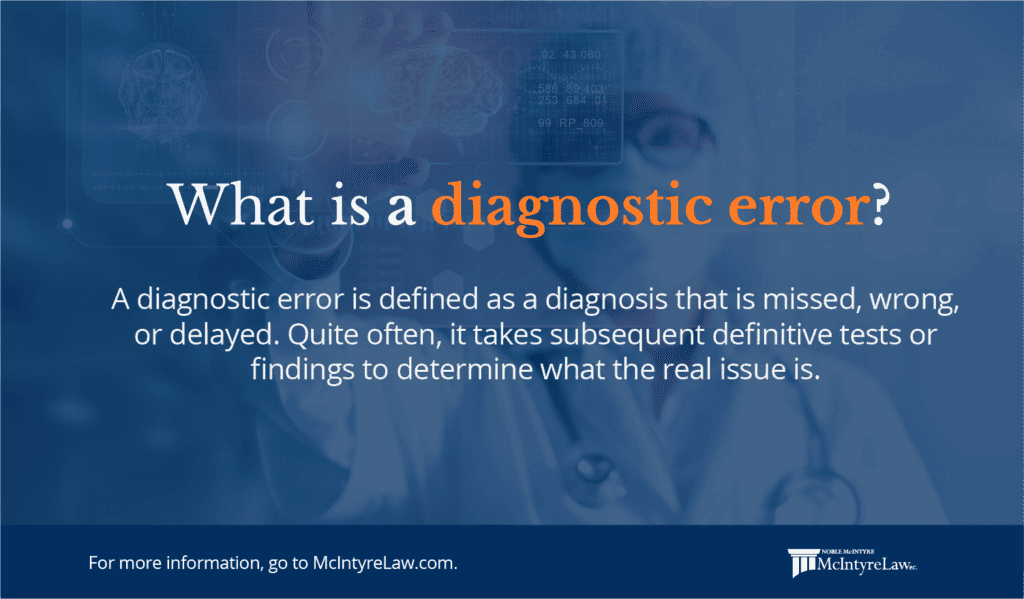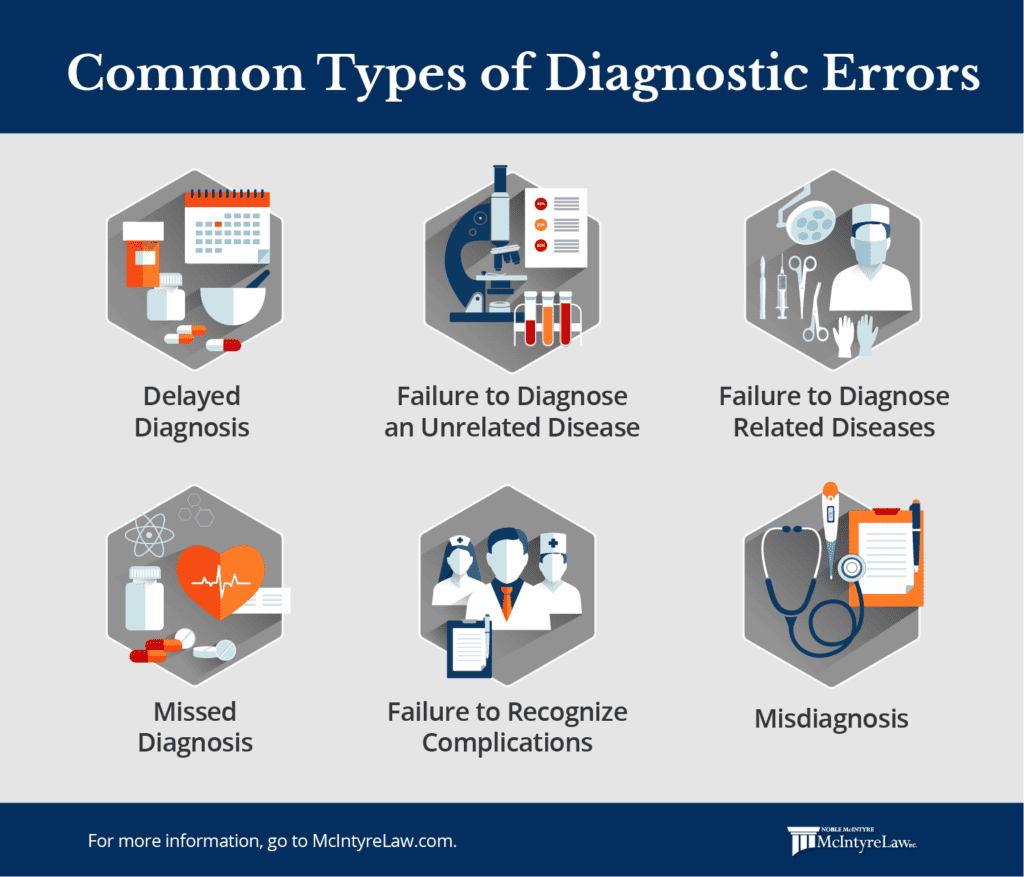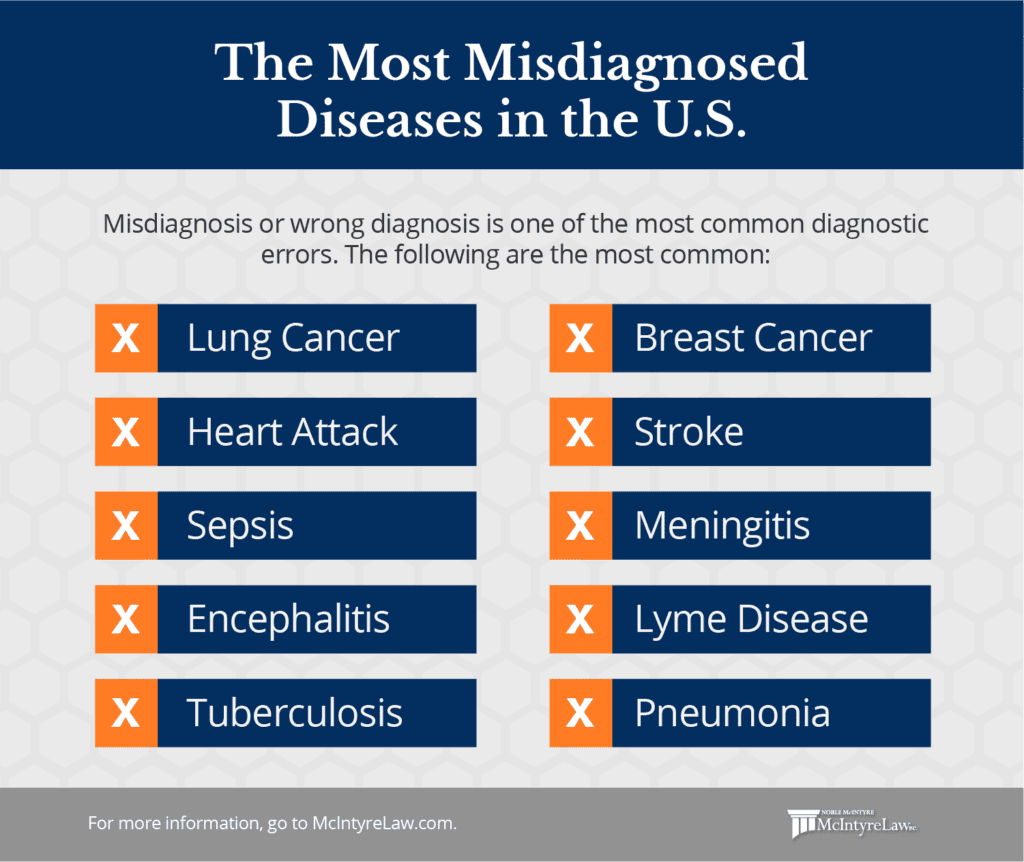What is a diagnostic error?
A diagnostic error is a diagnosis that is missed, wrong, or delayed. It often takes additional tests or findings to determine what the real issue is. When a misdiagnosed illness goes untreated or is treated incorrectly, it can have a number of negative consequences for the patient.
Are diagnostic errors considered medical malpractice?
There are various scenarios in which a medical error becomes malpractice. These include:
- Cases where negligence is a factor. Medical negligence can rise to malpractice when doctors fail to diagnose harmful conditions, when healthcare workers fail to properly advise patients of risks for treatments, and when unacceptable errors occur during surgery or other procedures.
- Cases of recklessness. Reckless behaviors are actions where doctors perform surgery or other procedures in a careless manner. An example would be a doctor who works while under the influence of drugs or alcohol, or administers potentially lethal levels of medications to patients.

When a diagnostic error isn’t medical malpractice
There are two circumstances in which cases of diagnostic error are not considered malpractice:
- When a patient’s condition worsens over time. Sometimes, doctors are unable to treat illnesses, even in cases where conditions are considered treatable. No treatment is guaranteed to succeed. As long as a doctor acted with reasonable care and skill in selecting and carrying out treatment for a patient, it can’t be considered medical malpractice.
- When a patient suffers from an untreatable condition. Not every health condition and illness is treatable. When doctors correctly diagnose health problems and make sound decisions regarding how to proceed with care, it can’t be said that the doctor acted negligently or recklessly in providing care for the patient.
Common types of diagnostic errors
Recent studies indicate that as many as a quarter of a million Americans die each year from medical errors. That makes it the third leading cause of death in the United States. Among these medical errors are numerous types of diagnostic errors that can cause pain and suffering in patients.

To protect your health and that of a loved one, it’s important to examine all the different types of diagnosis errors that can occur, including:
- Delayed diagnosis. This is when a doctor eventually makes the correct diagnosis, but it takes a significant period of time. Delaying a proper diagnosis can cause illnesses to progress and worsen and, in some cases, make treating them no longer possible.
- Failure to diagnose an unrelated disease. This occurs when a medical professional accurately diagnoses a specific disease in a patient but fails to diagnose another unrelated disease that was also present.
- Failure to diagnose related diseases. This type of diagnostic error occurs when a doctor correctly diagnoses one disease but doesn’t diagnose another related disease.
- Failure to recognize complications. This error describes when doctors make the correct diagnosis for a patient but fail to identify certain complications or other factors that may change or aggravate the condition.
- Missed diagnosis. This type of diagnostic error occurs when a doctor gives a patient a clean bill of health in cases where that patient is actually suffering from a disease or illness.
- Misdiagnosis. A misdiagnosis occurs when a doctor diagnoses a patient with the wrong illness.
Misdiagnosis
Misdiagnosis, or wrong diagnosis, is one of the most common diagnostic errors in the United States, with an estimated 12 million cases being reported each year. In some cases, the misdiagnosed illness can be resolved even after a late diagnosis. In others, the misdiagnosis gives the illness enough time to worsen beyond the point of treatment, leading to other serious medical complications or even wrongful death.
Generally, doctors are most likely to misdiagnose a rare disease or a disease that causes a wide range of nonspecific symptoms.
What is the most misdiagnosed disease?
Although a misdiagnosis can happen at any time, research has shown that three types of health conditions — infections, cancers, and vascular events — account for nearly 75% of serious misdiagnosis-related harms. Within these three categories, there are a handful of specific illnesses that tend to get misdiagnosed more than others.
Diseases that are frequently misdiagnosed:
- Pneumonia
- Lung cancer
- Breast cancer
- Heart attack
- Stroke
- Sepsis
- Meningitis and encephalitis
- Lyme disease
- Tuberculosis

Wrong diagnosis in the emergency room
Emergency rooms are fast-paced, high-pressure environments meant to treat serious or life-threatening injuries. As a result, it’s common for ER doctors to make medical mistakes like wrong diagnosis. One of the most sobering misdiagnosis statistics is that approximately 1 in 9 patients are misdiagnosed in the emergency room, often resulting in further health complications and a longer hospital stay. In some cases, a misdiagnosed condition can even lead to surgical errors if the doctors perform a wrong or unnecessary procedure.
The health conditions most commonly misdiagnosed in the emergency room:
- Heart attack
- Appendicitis
- Pulmonary embolism
- Gastrointestinal bleeding
- Bone fractures
- Pneumonia
- Stroke
Common causes of diagnostic errors
The process of diagnosing a medical condition is complicated, allowing plenty of room for mistakes. These diagnostic errors can result from a wide variety of factors, many of which are preventable.
Some of the most common causes of diagnostic error include:
- The medical equipment is faulty or outdated.
- The doctor has insufficient medical knowledge.
- The doctor fails to gather the right information.
- The doctor fails to check the patient’s medical history.
- The doctor rushes to make a diagnosis.
- The doctor is sleep-deprived.
- The doctor is impaired.
- The doctors fail to communicate effectively.
- The patient provides misleading information.
- The disease has atypical or wide-ranging symptoms.
- The medical facility is understaffed or lacks funding.
Can you sue a doctor for a diagnostic error in Oklahoma?
In Oklahoma, you can sue a doctor for wrong diagnosis in a medical malpractice lawsuit. However, there are certain conditions that must be met in order for you to have a case:
- There was a doctor-patient relationship. The doctor agreed to see you, diagnosed you, and offered treatment.
- The doctor acted negligently. The doctor acted against the “medical standard of care,” failing to provide treatment that a competent doctor would have provided under the same circumstances.
- The doctor’s negligence caused harm to the patient. The doctor directly caused harm or injury to the patient through their negligent actions.
- The case is filed within the statute of limitations. The injured patient files a lawsuit within the statute of limitations. In Oklahoma, you’re allowed two years from the time of injury to take legal action.
Are there any instances when you would sue a hospital instead?
Can you sue a hospital for misdiagnosis? Rarely. In general, the hospital or healthcare facility where your doctor practices can’t be held legally accountable for medical misdiagnosis cases. That’s because doctors aren’t employed by the hospitals in which they work; they’re independent contractors that operate within the hospital. This means that the healthcare facility can’t be held responsible if the doctor commits a negligent action.
The only time you may be able to file a lawsuit against the healthcare facility itself is when the negligent doctor is a direct employee of the facility.
How an Oklahoma malpractice attorney can help you
If you think that your doctor misdiagnosed your medical condition, it’s very important that you act quickly to ensure that your health and life are protected. If you suspect negligence or reckless behavior, contact the Oklahoma malpractice attorneys at McIntyre Law. Proving misdiagnosis is complicated, involving the collection of medical records, finding expert witnesses, and extremely detailed paperwork, and you should have the help of an experienced legal team. We’ll evaluate your case, explain the legal process, and work tirelessly to get you the compensation you deserve.

